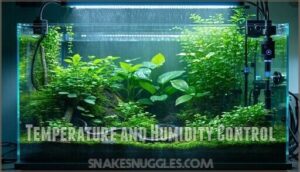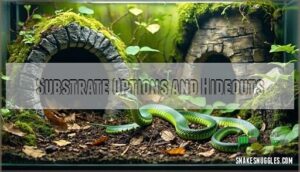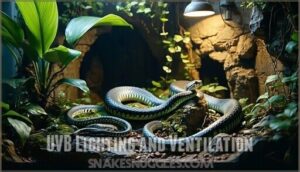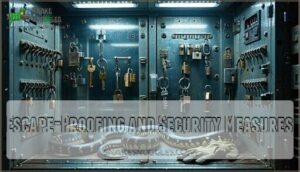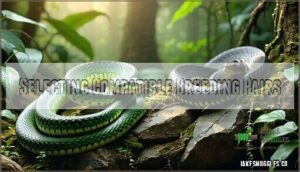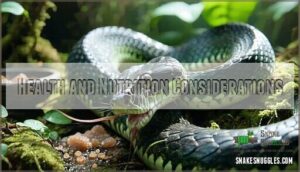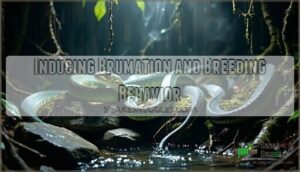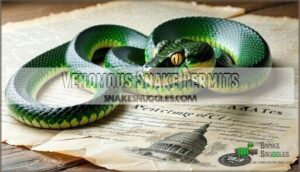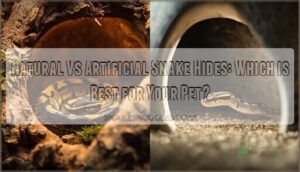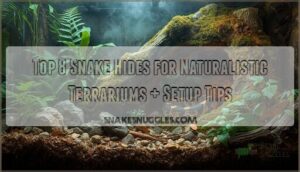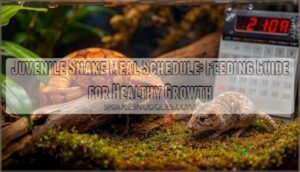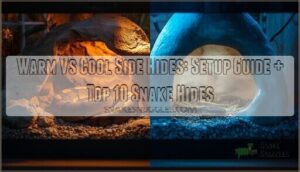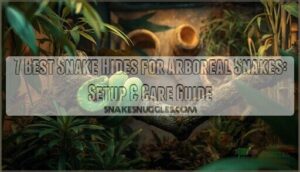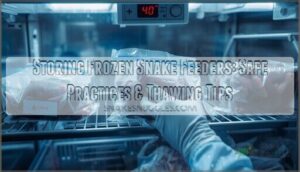This site is supported by our readers. We may earn a commission, at no cost to you, if you purchase through links.
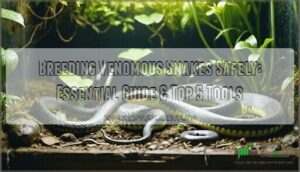 Breeding venomous snakes safely requires specialized equipment, proper permits, and extensive knowledge.
Breeding venomous snakes safely requires specialized equipment, proper permits, and extensive knowledge.
You’ll need secure enclosures with escape-proof locks, professional handling tools like snake hooks and tongs, and climate control systems.
Most importantly, you must obtain legal permits before starting—illegal venomous snake breeding carries serious penalties.
Health monitoring, genetic tracking, and emergency protocols are non-negotiable.
Female health becomes critical during breeding season, as stress can trigger dangerous defensive behaviors.
Even experienced handlers face life-threatening risks daily.
The right equipment and preparation methods can mean the difference between success and catastrophe.
Table Of Contents
- Key Takeaways
- Safe Snake Enclosures
- Top 5 Breeding Essentials
- Breeding and Genetics
- Venomous Snake Permits
- Frequently Asked Questions (FAQs)
- Is it illegal to breed venomous snakes?
- Can a copperhead and a rattlesnake breed?
- Can you crossbreed venomous snakes?
- What are the problems with breeding snakes?
- What antivenom should I keep on hand?
- How do I handle breeding aggression?
- When should I separate breeding pairs?
- What are signs of egg binding?
- How do I transport venomous snakes?
- Conclusion
Key Takeaways
- You’ll need specialized equipment and permits before starting – secure enclosures with escape-proof locks, professional handling tools like snake hooks and tongs, climate control systems, and legal permits are non-negotiable requirements.
- Temperature control is critical for breeding success – you must maintain proper heating gradients with warm sides at 85°F and cool sides at 75°F, plus species-specific humidity levels ranging from 30-40% for desert species to 70%+ for tropical ones.
- Legal compliance varies dramatically by location – research both state and local laws thoroughly, since some states completely ban venomous snake ownership, while others require extensive permits, inspections, and ongoing record-keeping.
- Safety protocols can’t be compromised – you’re working with potentially deadly animals that require redundant security measures, emergency preparedness, and constant vigilance, since one mistake could result in catastrophic consequences.
Safe Snake Enclosures
You’ll need a secure enclosure that balances safety with your snake’s biological needs, since even the most experienced handlers can face dangerous situations with venomous species.
The right setup protects both you and your snake while creating conditions that support successful breeding and long-term health.
Temperature and Humidity Control
Temperature control is the foundation of successful venomous snake breeding. You’ll need to create heating gradients with warm sides reaching high 80s and cool sides in mid-70s.
Perfect temperature gradients separate successful breeders from beginners—warm zones at 85°F, cool zones at 75°F.
Environmental conditions must remain stable through consistent monitoring equipment like quality thermometers and hygrometers. A vital aspect is establishing a thermal gradient for the snake’s well-being.
- Heating gradients: Use under-tank heating elements and low-wattage bulbs to create proper temperature zones
- Humidity sources: Maintain species-specific levels (30-40% for desert species, 70%+ for tropical) through misting and water features
- Seasonal adjustments: Modify microclimates importance during breeding cycles, reducing temperatures for brumation periods
Substrate Options and Hideouts
Beyond simply placing bedding in your venomous snake’s enclosure, you’ll need to balance safety with your snake’s natural behaviors.
The right substrate and hideouts create a secure environment while simplifying maintenance routines.
| Substrate Type | Best For | Cleaning Frequency |
|---|---|---|
| Aspen Shavings | Dry species, easy spot-cleaning | Weekly full changes |
| Cypress Mulch | Humidity-loving species | Bi-weekly with spot cleaning |
| Newspaper | Quarantine, easy monitoring | Replace after each feeding |
Choose substrate depth of 2-3 inches for burrowing species, less for arboreal ones.
Hideout size should allow your snake to curl up completely while touching the sides.
Naturalistic substrates like cypress offer enrichment but require more frequent cleaning than newspaper.
Your terrarium setup needs hideouts on both warm and cool sides for proper thermoregulation.
Providing secure snake shelters is essential for reducing stress.
UVB Lighting and Ventilation
While proper substrate keeps your snakes comfortable, UVB lighting and ventilation systems maintain their health year-round.
Many venomous snake breeding programs overlook these factors, leading to respiratory issues and poor breeding success.
Consider these key ventilation requirements:
- Airflow patterns should create gentle circulation without drafts that stress animals
- Mold prevention through proper humidity control and consistent air exchange
- Escapeproof ventilation using secure mesh or filtered systems that prevent access
UVB benefits include vitamin D3 synthesis, though requirements vary by species. Many breeders source reptile UVB lights for their enclosures.
Proper lighting spectrum supports natural behaviors essential for successful venomous snake breeding and reptile breeding safety.
Escape-Proofing and Security Measures
Your enclosure integrity depends on redundant locking mechanisms that prevent unauthorized access.
Install escape-proof enclosures with secure latches, secondary containment systems, and alarm systems for added protection.
Keep snake hooks and handling tools readily available for emergency protocols.
Regular inspections help identify potential weaknesses before they become problems.
Consider reliable enclosure hardware for enhanced security.
Remember, one loose lock could mean disaster, and it is crucial to ensure that all locks are secure to prevent unauthorized access.
Top 5 Breeding Essentials
You’ll need specialized tools to handle venomous snakes safely during breeding operations.
These five essential items provide the security and control necessary for successful breeding while minimizing risk to both you and your animals.
1. DocSeward Copperhead Snake Hook Field Length
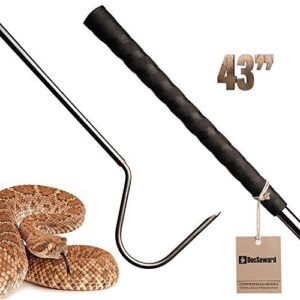
When handling venomous snakes, you’ll need reliable equipment that keeps you safe while maintaining control.
The DocSeward Copperhead Snake Hook Field Length delivers exactly that with its 43-inch reach and stainless steel construction.
This professional-grade tool combines copper and steel for durability without excess weight.
The secure rubber grip prevents slips during critical moments, while the beveled edge slides smoothly under snakes.
Field researchers trust this hook for capturing and relocating venomous species safely.
Best For: Professional and amateur reptile handlers, field researchers, and anyone needing a durable, safe tool for managing venomous or large snakes.
- Higher price point compared to some other snake hooks
- Slight risk of rusting if not regularly cleaned and dried
- May be less suitable for handling very large snakes that require an even longer hook
- Durable stainless steel and copper construction resists wear and corrosion
- 43-inch length allows safe handling of venomous snakes at a distance
- Secure rubber grip and ergonomic design provide excellent control and comfort
2. Fnova 52 Inch Snake Tongs
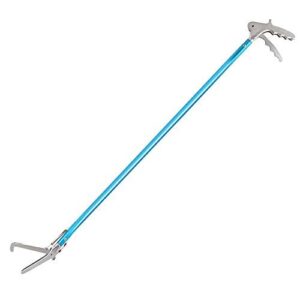
Nothing beats having reliable tongs when you’re dealing with venomous snakes.
The Fnova 52 Inch Snake Tongs give you the perfect distance from danger with their lightweight aluminum construction and spring-loaded mechanism.
You’ll appreciate the wide, serrated jaws that grip securely without harming your snakes. The pistol grip handle reduces hand fatigue during longer sessions, though the lack of non-slip coating can be tricky in humid conditions.
These tongs work great for both capture and controlled release. For ideal safety, consider appropriate snake tongs length based on the snake’s size.
Best For: Homeowners, hikers, and field workers who need a safe, versatile tool for handling or relocating snakes in a variety of environments.
- Jaw thickness makes grabbing snakes in tight spaces or on rocks difficult.
- Handle lacks a non-slip grip, making it less secure to use in wet or humid conditions.
- Locking mechanism only works with empty jaws, offering limited security when holding a snake.
- Lightweight, sturdy aluminum construction with a 52-inch reach keeps users at a safe distance from snakes.
- Wide, serrated jaws securely grip snakes without causing injury, suitable for multiple tasks like clearing trails or picking up debris.
- Ergonomic pistol grip reduces hand fatigue and allows for one-handed operation in most situations.
3. REPTI Zoo 67 Gallon Terrarium
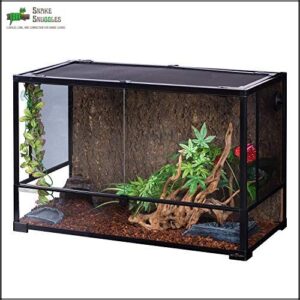
When your venomous snake breeding program demands serious space and security, the REPTI Zoo 67 Gallon Terrarium delivers both.
This 36"L x 18"W x 24"H enclosure features thick tempered glass construction that won’t crack under pressure.
The lockable front doors prevent escapes while allowing safe access for feeding and cleaning.
The mesh top provides excellent ventilation and UVB penetration essential for healthy breeding.
The raised bottom accommodates heat pads perfectly, creating proper thermal gradients your snakes need for successful reproduction.
Best For: Breeders and keepers of venomous snakes or large reptiles who need a secure, spacious, and escape-proof enclosure with excellent ventilation and environmental control.
- Heavy weight (55-60 lbs) makes moving and placement challenging
- Mesh sides may not be ideal for reptiles needing very high humidity
- Occasional quality control issues with glass panels or door alignment reported during assembly
- Tempered glass and lockable front doors maximize safety and prevent escapes
- Raised bottom and waterproof base support heat pads and humidity control for optimal breeding conditions
- Mesh top and side ventilation allow for proper airflow and UVB/infrared penetration
4. Reptile Heating Pad Thermostat Combo
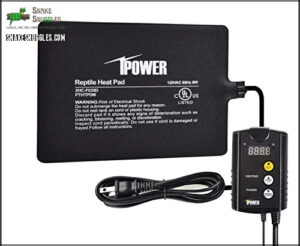
In the context of maintaining consistent temperatures for your venomous breeding stock, you’ll need a reliable heating pad thermostat combo that won’t let you down.
Digital thermostats maintain temperatures within a 2-3°F buffer zone, which is vital for reproductive success.
Look for units with PTC heating technology that prevent dangerous overheating while delivering uniform heat distribution.
The thermostat probe placement directly above the heat mat guarantees accurate temperature control, though you should verify readings with an independent thermometer to prevent lethal errors.
Best For: Reptile, amphibian, small animal, or plant terrarium keepers who need precise and reliable temperature control, especially those managing breeding stock or delicate species.
- Adhesive may fail over time, leading to improper placement or reduced effectiveness.
- Occasional thermostat malfunctions and temperature fluctuations reported by users.
- Inadequate heating for larger or incorrectly sized enclosures.
- Accurate digital thermostat maintains stable temperatures within a narrow 2–3°F buffer.
- Uniform heat distribution from PTC technology prevents overheating and supports healthy environments.
- Quick-heating, energy-efficient design with easy plug-and-play setup.
5. LUCKY HERP Reptile UVB Light
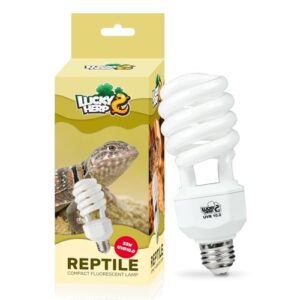
While many snake species thrive without UVB lighting, the LUCKY HERP Reptile UVB Light 10.0 offers valuable benefits for venomous snake breeding programs.
This 23-watt bulb provides moderate UVB output, making it suitable for species requiring lower exposure levels like boa constrictors and western hognose snakes.
You’ll need to position it carefully since mesh screens reduce effectiveness. The bulb encourages natural behaviors, supports vitamin D3 synthesis, and may enhance reproductive health.
However, don’t rely on it for heating—pair it with separate heat sources for ideal enclosure conditions, ensuring a comprehensive approach to create an optimal environment for your snakes.
Best For: Keepers of snakes and reptiles with moderate UVB needs, such as boa constrictors and western hognose snakes, especially in breeding setups where UVB is beneficial but high exposure is not required.
- UVB output is too low for species requiring high exposure, like bearded dragons.
- Not suitable as a primary heat source; must be used alongside separate heating.
- Reported inconsistency in lifespan and occasional premature bulb failure.
- Supports vitamin D3 synthesis and calcium absorption, encouraging healthy metabolism and behavior.
- Energy-efficient and designed for reptiles needing moderate UVB, fitting standard E26 lamp bases.
- May improve coloration, appetite, and overall activity in some reptiles.
Breeding and Genetics
You’ll need to master genetic planning before attempting venomous snake breeding, as poor pairing decisions can create serious health problems in offspring.
Successful breeding requires careful attention to bloodlines, health screening, and precise environmental manipulation to trigger natural reproductive cycles, which involves understanding and applying precise environmental controls.
Selecting Compatible Breeding Pairs
Beyond simply pairing snakes, you’ll need to evaluate genetic background, health assessment, and temperament matching carefully.
Age considerations matter—snakes should be mature and physically ready. Review breeding history to avoid problematic bloodlines.
Compatible breeding pairs require thorough behavioral indicators assessment, watching for stress or aggression. Physical indicators like size compatibility prevent injuries.
Genetic variations can create unique combinations. Genetic diversity guarantees healthy offspring under ideal breeding conditions, ensuring a successful breeding process with healthy offspring and ideal breeding conditions.
Genetic Diversity and Lineage Tracking
Responsible breeders maintain detailed studbook management systems to track lineages and prevent inbreeding depression.
You’ll need outcrossing strategies between facilities, plus DNA analysis to assess genetic diversity.
Ethical breeding prioritizes conservation focus over profit, avoiding extreme traits.
Snake genetics require careful documentation – reptile genetics databases help preserve species integrity while maintaining healthy bloodlines for future generations.
Health and Nutrition Considerations
Your snake’s health depends on proper prey size selection—rodents should match your snake’s thickest body section.
Feed adults every two weeks, juveniles weekly, preventing obesity through portion control.
Fresh water and calcium supplementation support egg production in breeding females.
Monitor feeding frequency closely, adjusting portions based on body condition.
Balanced nutrition guarantees reproductive success and overall health management throughout breeding cycles.
Inducing Brumation and Breeding Behavior
Timing your breeding cycles correctly makes all the difference.
Start brumation preparation in September by reducing feeding schedules and adjusting lighting to twelve-hour cycles.
October brings total darkness with temperatures between 62-68 degrees for proper brumation length.
Resume normal temperature cycling and lighting schedules in November, then introduce breeding pairs after females complete their pre-breeding shed.
Venomous Snake Permits
Before you start breeding venomous snakes, you’ll need to understand the complex legal landscape that governs their ownership and breeding.
The regulations vary dramatically from state to state, with some places completely banning venomous species while others require extensive permits, inspections, and ongoing compliance requirements.
Researching Local Laws and Regulations
Before diving into venomous snake breeding, you must navigate the complex legal landscape surrounding these dangerous reptiles.
State-specific laws vary dramatically, with some states completely prohibiting ownership while others require extensive permits.
- Maryland bans all private venomous snake possession regardless of permits or experience
- Florida mandates permits for any medically significant species including hybrids
- Local ordinances may override state laws with stricter restrictions
Research both state regulations and local ordinances thoroughly, as violations carry serious legal penalties including fines and criminal charges.
In New York, possessing dangerous animals like venomous snakes for purposes such as education requires a dangerous animal license.
Obtaining Permits and Licenses
Once you’ve identified your state’s requirements, you’ll need to navigate the application process carefully.
Most states require extensive documentation, including proof of experience and facility inspections.
Here’s what you can expect:
| State | Experience Required | Key Requirements | Typical Costs |
|---|---|---|---|
| Florida | 1,000+ hours documented | Two professional references, facility inspection | $100-300 annually |
| Arkansas | Age 18+, clean record | Written application per facility, background check | $50-150 per permit |
| New York | Professional training | Antivenin agreements, educational/scientific purpose | $200-500 initial |
| Texas | Varies by species | Native species prohibited, non-native allowed with permits | $25-100 per species |
The application process involves submitting detailed paperwork about your experience, facility specifications, and safety protocols.
Most permits require annual renewal with updated documentation and continued compliance verification.
Compliance and Record-Keeping
Once you’ve secured your permit, maintaining detailed records becomes your lifeline.
You’ll need to document every snake acquisition with bills of sale and origin paperwork for at least five years.
Annual inventory reports listing all venomous reptiles by scientific name must be submitted to state agencies.
Facility inspections can happen unannounced, so keep your safety plans, staff training records, and compliance documentation current and accessible at all times.
Consequences of Non-Compliance and Illegal Trade
Breaking venomous snake laws triggers serious consequences.
Violating venomous snake laws means hefty fines, confiscated animals, and potential criminal charges.
Violations result in hefty fines and penalties, plus immediate confiscation risks for your animals.
Authorities prioritize public safety over personal collections.
Non-compliance harms conservation impact by fueling black market demand.
CITES violations compound legal trouble.
Understanding venomous snake legality prevents costly mistakes—snake laws exist for good reasons, making illegal trade exceptionally risky, as it undermines conservation impact.
Frequently Asked Questions (FAQs)
Is it illegal to breed venomous snakes?
When in Rome, do as the Romans do" – and when breeding venomous snakes, you’ll need to follow your local laws.
It’s not universally illegal, but regulations vary dramatically by location, from complete bans to strict permit requirements.
Can a copperhead and a rattlesnake breed?
No, copperheads and rattlesnakes can’t breed together. They’re different species from separate genera – copperheads are Agkistrodon while rattlesnakes are Crotalus. They’re genetically incompatible despite both being pit vipers.
Can you crossbreed venomous snakes?
You can’t crossbreed most venomous snakes since they’re different species. However, some closely related species like certain rattlesnakes can hybridize naturally, though it’s rare and discouraged by ethical breeders.
What are the problems with breeding snakes?
Walking through a minefield of challenges, you’ll face genetic issues, inbreeding depression, legal hurdles, expensive setups, disease risks, feeding difficulties, and the constant danger of working with potentially deadly animals.
What antivenom should I keep on hand?
Don’t keep antivenom on hand unless you’re a licensed facility with proper medical protocols. Emergency rooms stock species-specific antivenoms. Your focus should be bite prevention, not treatment.
How do I handle breeding aggression?
When tempers flare like striking serpents, you’ll need to separate aggressive pairs immediately. Use tubes or hooks to safely relocate snakes to individual enclosures, allowing cooling-off periods before reintroduction attempts.
When should I separate breeding pairs?
You’ll want to separate breeding pairs after successful copulation, typically within 24-48 hours.
Watch for signs like aggressive chasing, defensive posturing, or sustained combat behaviors that indicate it’s time to move them apart.
What are signs of egg binding?
Watch for lethargy, loss of appetite, straining without laying eggs, swollen abdomen, or visible eggs through the skin. You’ll notice restlessness, pacing, and prolonged basking behaviors indicating distress.
How do I transport venomous snakes?
Moving these dangerous beauties safely requires specialized containers, lockable transport tubes, and careful planning.
Use secure carriers with ventilation, handle boxes with snake hooks, and follow strict protocols.
Never transport alone—teamwork prevents accidents.
Conclusion
When push comes to shove, breeding venomous snakes safely demands unwavering commitment to proper protocols and equipment.
You’ve learned the essential tools, permit requirements, and safety measures that separate successful breeders from dangerous amateurs.
Remember, there’s no room for shortcuts when handling species that can kill you.
Your dedication to secure enclosures, temperature control, and emergency preparedness will determine whether you’ll thrive or face catastrophic consequences.
Start with proper permits, invest in quality equipment, and never underestimate these magnificent yet deadly creatures.
- https://www.gov.scot/publications/dangerous-wild-animals-species-guidance/pages/snakes/
- https://pmc.ncbi.nlm.nih.gov/articles/PMC7856910/
- https://sos.ms.gov/ACProposed/00022231b.pdf
- https://aszk.org.au/wp-content/uploads/2020/04/Reptiles.-Broad-headed-Snake-2009CM.pdf
- https://reptilesupershow.com/snake-handling-safety-tips-for-secure-encounters/

